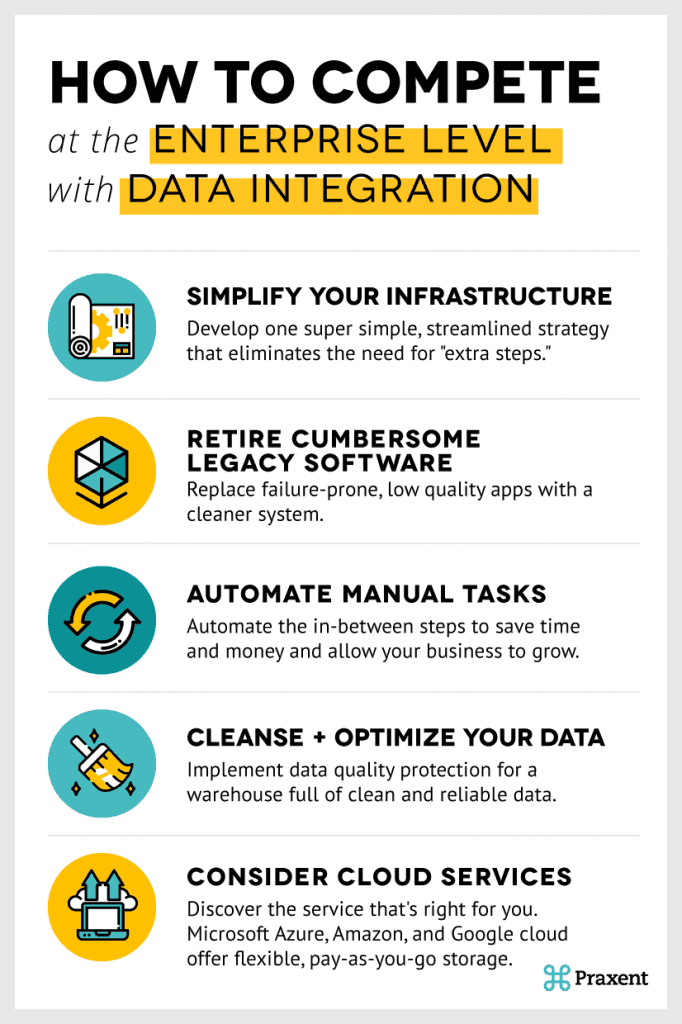
8 min read
Streamline, Automate, and Scale: What to Know about Serverless Data Integration
Streamline, Automate, and Scale: What to Know about Serverless Data Integration
Data integration is more than a modern buzz word. It’s a new way of thinking about technology and business operations. If you’re struggling to scale, wondering when technology will actually begin working for you, rather than the other way around, read on.
Is your factory operation running on outdated software or hardware? Are you a growing business that’s struggling to make use of big data? You could be sitting on a goldmine of valuable information. But the way you’re collecting and storing data is standing in the way of accessing that value — and your patched-up system of outdated software applications isn’t helping.
What is Data Integration?
Data integration allows businesses to consolidate data from a variety of sources within their system and turn it into meaningful, valuable information. Connecting disparate, disjointed systems opens the door for new insights, functional connectivity, and business capabilities that were formerly untapped.
Businesses large and small can benefit from a strategic data integration plan. Why? Because data integration is key to deepening capacity for ongoing, long-term growth. A good data integration strategy will help you optimize resources and eliminate waste.

How to Compete at the Enterprise Level with Cloud-Based Data Integration
1. Simplify your infrastructure
Picture this: your manufacturing plant relies on four different applications to accomplish one goal, and two of those applications only exist to fill in the gaps of the other two. At a certain point in this scenario, growth becomes too expensive to maintain.
Introducing new products into a clunky legacy ecosystem may require you to significantly refactor old software. The problem compounds from there if your software is lower quality or inadequately equipped with test coverage. And what if your team has turned over the knowledge keepers? Trying to expand a business in the midst of a system breakdown is counterproductive. The situation will only prevent innovation and stifle growth.
The simplest solutions are the most scalable. Find a way to streamline your processes and eliminate bottlenecks. Develop one super simple, scalable strategy that eliminates the need for “extra steps” and whole new hardware.
Simplification does not always require scrapping everything and starting over. As you critically examine the technical infrastructure of your business in its current state, you may discover untapped potential. A focused, simplified data integration strategy often ends up giving old data new meaning. By optimizing this data, businesses can create strategic advantages over competitors who are not leveraging their resources as effectively.
2. Retire cumbersome legacy software
Some applications seem to require more work than they are worth. Yeah, you know what we’re talking about. When the day-to-day workflow is constantly interrupted by system errors, and you have to employ a whole team of IT personnel just to keep it all patched together (yet somehow forever broken), how can you confidently plan for growth?
A data integration plan will allow you the freedom to pitch those expensive, outdated applications for good, and maybe leverage those IT guys for something that actually creates new business value.
3. Automate manual tasks
Manual labor, outdated software, and complicated systems go hand in hand. How much time and money could you save if you didn’t have to pay someone to manually fill in gaps in your system? And what about inaccurate data, which is just as costly, if not more?
Perhaps your system is not trustworthy, or somewhere in the chain of command from one app to the other, data falls through the cracks. Human error — people moving information from one place to another in their memory or on sticky notes — can create a huge amount of erroneous data.
Not only will automating those in-between steps save you tons of time and money right now, it will position your business to grow without having to hire new people. And if you automate using cloud resources, scalability and maintainability are built in.
>> Find out how workflow management software and task automation helped this point of purchase marketing company scale 3x.
4. Cleanse and optimize your data
If your business is operating on an unsteady system of pieced together software, it’s quite likely that the fear of incomplete or inaccurate data is holding you back.
An integration plan provides data quality protection. By eliminating the causes of error in your system and addressing complex processes with one simple solution, you can create a safe system free of data quality problems. From a place of security, you can move confidently forward with business decisions that were otherwise too risky.
With a warehouse full of clean and reliable data, you can even begin to explore new sources of value for your business.
<< Photomadic, an experiential marketing firm, identified a recurring revenue source from the system we created. Our solution provided a secure and consolidated way to view their clients’ social media data. The company capitalized on this opportunity to now offer marketing analytics software to their clients.
5. Consider cloud services
Where will you store your data and how will you move it around? Once you get started with data integration, you’ll have to decide whether to operate on owned hardware or move to the cloud.
Procuring servers and hardware applications to manage and store your data is a time consuming and costly process. But it certainly has its advantages. For one, you own the physical objects interacting with your data–you’re in complete control. You can’t get more secure than that. Because you own the hardware, the options of what you can do with those servers are limitless. But those options come with a trade-off. Owning and operating your own infrastructure typically slows software teams down.
If you’re a smaller company hesitant to take on the extra weight of maintaining your own servers, or if you have little to no time before your current system completely busts, consider cloud-hosted apps. Every business is different — we don’t recommend blanket solutions. But cloud-hosted apps are excellent candidates for quickly implementing data integration.
We recommend weighing the pros and cons of Microsoft Azure, Amazon, and Google cloud. Each one provides flexible, pay-as-you-go storage that facilitates seamless data integration with cloud functions.
Getting Creative with Data Integration in the Cloud
Global Resale refurbishes and sells used technology devices like laptops, cell phones and servers. In a huge warehouse, they test these used devices by the hundreds, scanning for quality and functionality. Once scanned and assessed, Global Resale creates product attributes that are visible in their store for customers to make educated purchases in line with their budgets and needs.
When Global Resale came to Praxent, they were testing nearly 1000 units simultaneously at their manufacturing plant in Austin, Texas. The process they were using to run the tests created a significant amount of data pollution. And the cost per test was eating into their profits.
It was an expensive, cumbersome, and slow infrastructure requiring a lot of manual maintenance at each step of the way. The poorly integrated system broke often, leaving Global Resale to pick up the slack in consulting costs.
Due to business constraints, Global Resale required an immediate solution. At this point, they were paying for two different testing apps, but only using one. They needed a sustainable, deep-fix solution — no more costly band-aids.
With only four weeks to deliver a fully functional, globally scalable, enhanced integration system, we quickly ruled out solutions that would require the time and expense of sizing, purchasing, and configuring hardware servers. And we turned to the cloud.
Using modern cloud computing, we designed and implemented a global solution that processed test and erasure results in two different countries. The solution extracts the raw plant-floor data, transforms it based on business rules, and loads the final results into the company’s legacy database.
After selling the computers, Global Resale retains the test information in a results warehouse. They use the data to glean valuable business and sales intelligence.
Our data integration solution is scalable enough that Global Resale can fully transform its business processes. The system takes on even more load than was originally asked for, opening the door to automate additional factory work.
Learn More
With Global Resale, we moved from whiteboard to production in less than a month. Our custom integration solution organizes their data into a cleansed, quality-controlled, legacy-friendly format. The system is streamlined, scalable, and serverless, allowing the company to reduce software and support costs, improve data quality for increased sales, and transform business processes. What’s next for Global Resale? Unlimited growth.


Leave a Reply